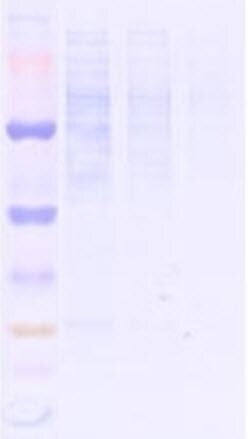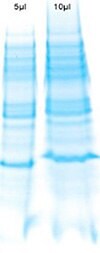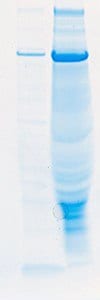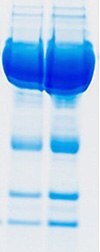Cell Lysate Preparation
Often, the first step of analyzing protein expression or protein-protein interactions is to obtain a cell or tissue sample, lyse the cells, and extract proteins using extraction reagents. Total protein concentration must be determined for these cell lysates. Variables affecting each of these steps are outlined below, as each could affect the sensitivity and reproducibility of the Western blot.
Click on the symptoms to read about the possible causes and remedies:
 Protein concentration too low as seen on Coomassie-stained membrane | Possible Cause | Remedy |
|---|---|---|
Heat degradation |
| |
Protein degradation |
| |
Inadequate tissue homogenization |
| |
Cell debris contamination |
| |
Too little tissue/too few cells |
| |
Wrong type of lysis buffer  Effect of excessively low sample pH on SDS-PAGE | Different proteins may be best visualized via Western blot using different lysis buffers. Consider the pH, buffering compound, detergents and other additives when determining the optimal buffer for a specific |
| Possible Cause | Remedy |
|---|---|
Insufficient buffer/tissue ratio |
|
| Possible Cause | Remedy |
|---|---|
Inaccurate pipetting |
|
Incorrect protein standard selected (for colorimetric assays) |
|
Time before reading absorbance too long (for colorimetric assays) |
|
Assay incompatible with buffers used |
|
Protein concentration outside of linear dynamic range of assay |
|
| Possible Cause | Remedy |
|---|---|
Pipetting error resulting in incorrect dilution of standards. |
|
| Possible Cause | Remedy |
|---|---|
Protein degradation due to insufficient protease inhibition |
|
| Possible Cause | Remedy |
|---|---|
Protein degradation |
|
Incompatibility between lysis buffer component and SDS  Effect of interfering detergents (right lane) in SDS-PAGE |
|
Excess concentration of abundant proteins, such as albumin, in the sample |
|
 Bands of interest on SDS-PAGE obscured by abundant proteins | Possible Cause | Remedy |
|---|---|---|
Excess concentration of abundant proteins, such as albumin, in the sample |
|
Network error: Failed to fetch
To continue reading please sign in or create an account.
Don't Have An Account?